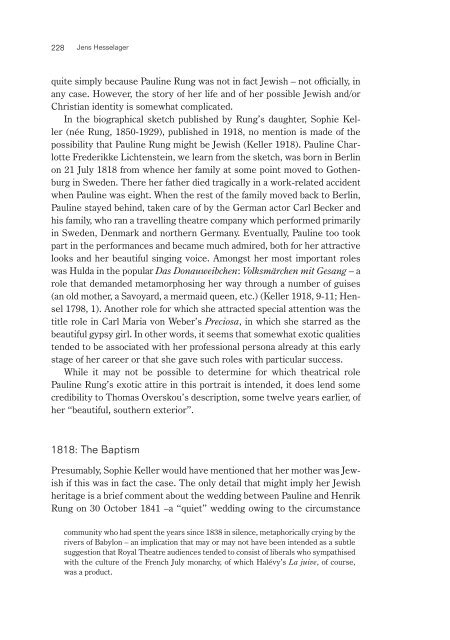Opera on the Move in the Nordic Countries during the Long 19th ...
Opera on the Move in the Nordic Countries during the Long 19th ...
Opera on the Move in the Nordic Countries during the Long 19th ...
Create successful ePaper yourself
Turn your PDF publications into a flip-book with our unique Google optimized e-Paper software.
228 Jens Hesselager<br />
quite simply because Paul<strong>in</strong>e Rung was not <strong>in</strong> fact Jewish – not officially, <strong>in</strong><br />
any case. However, <strong>the</strong> story of her life and of her possible Jewish and/or<br />
Christian identity is somewhat complicated.<br />
In <strong>the</strong> biographical sketch published by Rung’s daughter, Sophie Keller<br />
(née Rung, 1850-1929), published <strong>in</strong> 1918, no menti<strong>on</strong> is made of <strong>the</strong><br />
possibility that Paul<strong>in</strong>e Rung might be Jewish (Keller 1918). Paul<strong>in</strong>e Charlotte<br />
Frederikke Lichtenste<strong>in</strong>, we learn from <strong>the</strong> sketch, was born <strong>in</strong> Berl<strong>in</strong><br />
<strong>on</strong> 21 July 1818 from whence her family at some po<strong>in</strong>t moved to Go<strong>the</strong>nburg<br />
<strong>in</strong> Sweden. There her fa<strong>the</strong>r died tragically <strong>in</strong> a work-related accident<br />
when Paul<strong>in</strong>e was eight. When <strong>the</strong> rest of <strong>the</strong> family moved back to Berl<strong>in</strong>,<br />
Paul<strong>in</strong>e stayed beh<strong>in</strong>d, taken care of by <strong>the</strong> German actor Carl Becker and<br />
his family, who ran a travell<strong>in</strong>g <strong>the</strong>atre company which performed primarily<br />
<strong>in</strong> Sweden, Denmark and nor<strong>the</strong>rn Germany. Eventually, Paul<strong>in</strong>e too took<br />
part <strong>in</strong> <strong>the</strong> performances and became much admired, both for her attractive<br />
looks and her beautiful s<strong>in</strong>g<strong>in</strong>g voice. Am<strong>on</strong>gst her most important roles<br />
was Hulda <strong>in</strong> <strong>the</strong> popular Das D<strong>on</strong>auweibchen: Volksmärchen mit Gesang – a<br />
role that demanded metamorphos<strong>in</strong>g her way through a number of guises<br />
(an old mo<strong>the</strong>r, a Savoyard, a mermaid queen, etc.) (Keller 1918, 9-11; Hensel<br />
1798, 1). Ano<strong>the</strong>r role for which she attracted special attenti<strong>on</strong> was <strong>the</strong><br />
title role <strong>in</strong> Carl Maria v<strong>on</strong> Weber’s Preciosa, <strong>in</strong> which she starred as <strong>the</strong><br />
beautiful gypsy girl. In o<strong>the</strong>r words, it seems that somewhat exotic qualities<br />
tended to be associated with her professi<strong>on</strong>al pers<strong>on</strong>a already at this early<br />
stage of her career or that she gave such roles with particular success.<br />
While it may not be possible to determ<strong>in</strong>e for which <strong>the</strong>atrical role<br />
Paul<strong>in</strong>e Rung’s exotic attire <strong>in</strong> this portrait is <strong>in</strong>tended, it does lend some<br />
credibility to Thomas Overskou’s descripti<strong>on</strong>, some twelve years earlier, of<br />
her “beautiful, sou<strong>the</strong>rn exterior”.<br />
1818: The Baptism<br />
Presumably, Sophie Keller would have menti<strong>on</strong>ed that her mo<strong>the</strong>r was Jewish<br />
if this was <strong>in</strong> fact <strong>the</strong> case. The <strong>on</strong>ly detail that might imply her Jewish<br />
heritage is a brief comment about <strong>the</strong> wedd<strong>in</strong>g between Paul<strong>in</strong>e and Henrik<br />
Rung <strong>on</strong> 30 October 1841 –a “quiet” wedd<strong>in</strong>g ow<strong>in</strong>g to <strong>the</strong> circumstance<br />
community who had spent <strong>the</strong> years s<strong>in</strong>ce 1838 <strong>in</strong> silence, metaphorically cry<strong>in</strong>g by <strong>the</strong><br />
rivers of Babyl<strong>on</strong> – an implicati<strong>on</strong> that may or may not have been <strong>in</strong>tended as a subtle<br />
suggesti<strong>on</strong> that Royal Theatre audiences tended to c<strong>on</strong>sist of liberals who sympathised<br />
with <strong>the</strong> culture of <strong>the</strong> French July m<strong>on</strong>archy, of which Halévy’s La juive, of course,<br />
was a product.
















